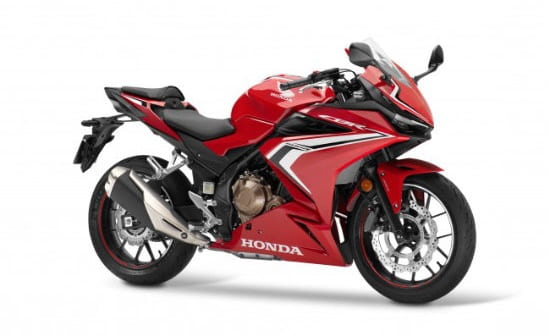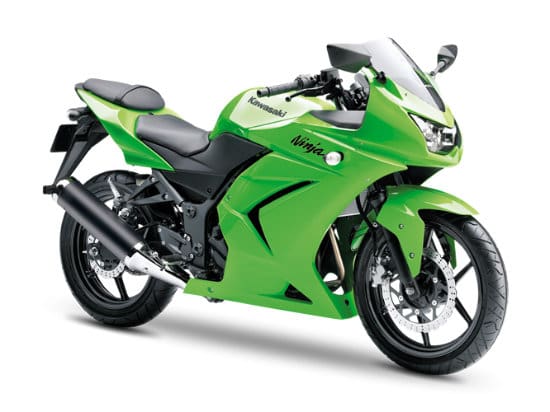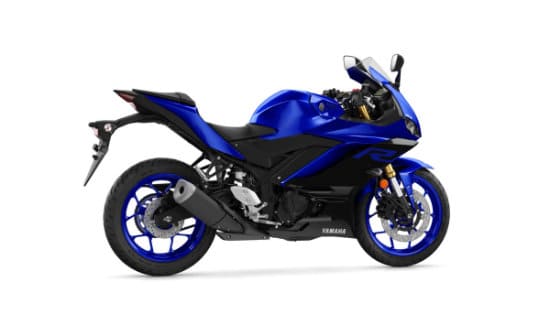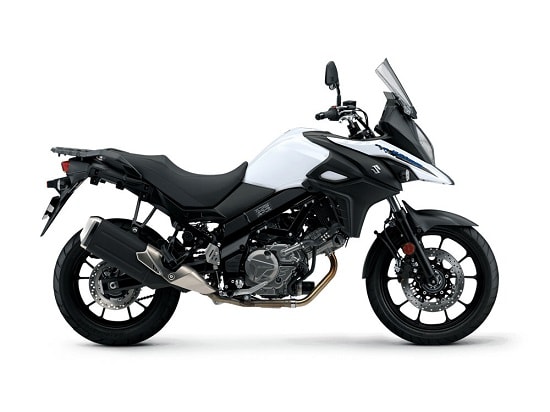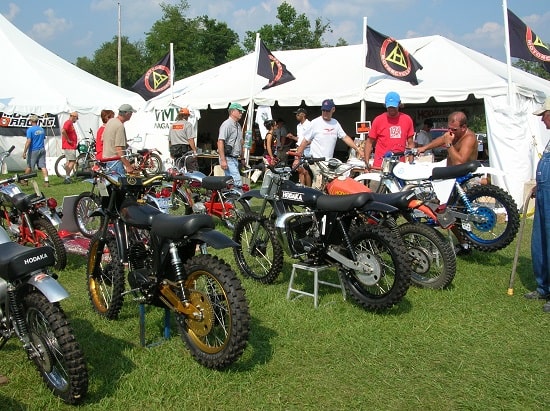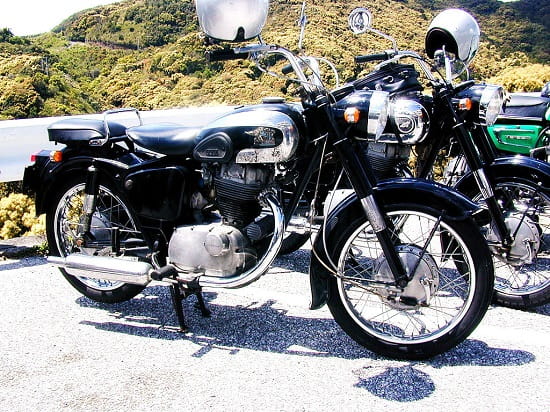Even those outside of the motorcycle community will likely have heard of one if not all of the ‘Big Four’ Japanese brands.
Suzuki, Honda, Yamaha, and Kawasaki.
They are a dominant force in the world of all things two wheels and have been since each company was formed.
From inception to date they have competed to be the best and pushed each other to continually produce mind-blowing motorcycles.
From dirt bikes, road bikes, racing bikes Japanese machines are at the forefront of motorcycle innovation, design, technology, style and performance.
Not only are we going to take a look at the ‘Big Four’ but I have gathered together a few of the lesser-known Japanese manufacturers too, that have impacted the motorcycle industry.
Let’s get started.
Save Money On Your Motorcycle Insurance
- You could pay less than £195*
- Compare quotes from 25+ UK providers
- Fill in one form to compare top bike insurers
Honda
Soichiro Honda had grown up working for his father’s bicycle repair service before training to be a mechanic.
Shortly after WWII, Honda created his first motorcycle by retro-fitting a generator motor to a bicycle.
In 1948 Honda formed a partnership with Takeo Fujisawa and the Honda Motor Company was born, by 1949 the first official Honda motorcycle was produced called the ‘Dream’ D-type.
It is said that Soichiro Honda went around to many small garages and home mechanics in Japan and persuaded them to become solely Honda dealers to get a foothold in an already bustling competitive motorcycle industry.
By the mid-’50s, Honda was the biggest motorcycle manufacturer in Japan and by 1959 Honda had branched out to start sales overseas in the USA.
Throughout the 1960s Honda focused on producing bigger, better and faster motorcycles to compete in ever-growing racing circuits around the world.
Upon the release of the CB750 Honda had set a precedent to keep building upon a very sturdy foundation of reliable, powerful machines.
The 1970s and ’80s saw many two-stroke machines produced to compete in the GP World Championships such as the NSR250, a brilliant two-stroke track demon.
Honda went on to produce some incredible machines throughout the 1990s after emissions laws were tightening on two-strokes.
The decade saw the release of the Super Blackbird and Fireblade and even a big cruiser called the Valkyrie.
It is safe to say that Honda has continued to dominate the motorcycle industry continuing to evolve throughout the years, with a finger constantly on the pulse of what motorcycle lovers want and need.
Date Formed: The Honda Motor Company was formed in 1948.
Iconic classic Honda’s:
- 1958 – The Honda Super Cub was produced. It is the best-selling motorised transport of all time, largely down to its accessibility, affordability and ease of use. The descendant of the Super Cub remains in production today.
- 1969 – The Honda CB750 Four was developed. While often disputed the CB750 claims the title of the ‘World’s First Superbike’.
- 1974 – The Honda Goldwing was produced. Predominantly for the US market to compete directly with Harley Davidson. The Goldwing was a big sturdy touring motorcycle that would go on to be one of Honda’s most popular models with a 30 year stint of being produced in Ohio.
- 1992 – Honda CBR900RR Fireblade. This was the bike that set the standards for lightweight superbikes that we know today.
Current best models:
- CB125F/R – The 125cc learner motorcycle from Honda is a staple in riding schools garages and makes for the perfect bike for new riders to cut their teeth on.
- CMX500 Rebel – A baby cruiser that offers an affordable option for those who don’t quite want to spend a fortune on American Iron for a cool cruiser. So popular the 500 Rebel has proven, that Honda has since released a bigger CMX1100 Rebel.
- CRF1100L Africa Twin – A dual-sport ultimate adventure machine. The Africa Twin harks back to the first Dakar Rally and Honda’s ability to produce a machine that could complete the gruelling challenge.
- CBR650R – A very popular sportsbike with plenty of power, a bulletproof engine and all the Honda racing tech to provide even amateur racers a fun ride on the track or street.
Kawasaki
Kawsaki’s origins go back further than any other Japanese manufacturer, as far back as 1878 however, it was not motorcycles that they applied their trade to, but boats, planes and industrial builds.
In fact in 1906 Kawasaki had produced the first submarine in Japan and by 1922 they had built their first aeroplane.
They did not turn their hand to motorcycles until 1962 when they produced the Kawasaki B8 a 125cc with a top speed of 62mph.
Following the release of the B8, a series of 50cc-250cc two-strokes were developed and advertised at the US market with a 250cc model named ‘Samurai’ attracting the most attention.
By 1966 the 650W1 was released and was the biggest motorcycle in Japan at the time based on the BSA A10.
In 1969 Kawasaki released the H1 (Mach III) and it was one of the quickest production bikes in the quarter-mile with a 500cc engine.
The H2R 750 followed and it was the fastest production racer motorcycle of the time having a successful run on the race track.
It wasn’t long before the 900cc Z1 was released followed by the Z1000 and this is largely considered one of the best motorcycles to come out of the 1970s.
Throughout the 1980s and into the 1990s Kawasaki produced race-winning motorcycles that would perform over and over again, as well as continuing to develop bigger engines based on those that came before.
The GPZ series was a huge win for Kawasaki in the GP circuits, in 1983 the first Ninja appeared and slowly ZXR bikes started appearing on the street in various capacities as serious race replicas.
Today Kawasaki continues to look back to their past for inspiration while fearlessly driving forward to be the best.
It is their current lineup that best displays this sentiment, the Z650RS has been revealed as a retro throwback to the original Z series but is loaded with modern tech such as ABS.
Alongside this, the new Ninja H2R produces a maximum of 310 horsepower with a top speed of over 200mph.
Both are equally awesome machines but for two different audiences and purposes.
Date Formed: The Kawasaki company goes as far back as 1878 however, their first motorcycle was not produced until 1961 for the 1962 model year.
Iconic classic Kawasaki’s:
- 1966 – Kawasaki 650W1 set the benchmark as the biggest capacity motorcycle in Japan for the time prior to the release of the H2 750.
- 1971 – Kawsaki H2R/H2 was released and in development, often referred to as the ‘Widow-Maker’, the H2R on the track was a formidable beast, but for the average rider it was an untamed stallion that only few could master.
- 1973 – The Kawasaki Z1000 was just the first in a long run of the Z series that is still in production today in various guises. It was the first of Kawasaki’s dominance of producing fast superbikes.
- 2004 – The ZX10R is unleashed with a crazy amount of power that only the brave would consider trying to utilise its full potential.
Current best models:
- Ninja H2R – Arguably responsible for creating the ‘Hypersport’ category, the modern H2 is an insane monster with a supercharger, built to impeccable spec.
- Vulcan S – A comfortable cruiser combining cruiser comfort with sporty performance, the Vulcan S is a pretty good compromise for those wanting the best of both worlds.
- KX450 – The KX450 is a competent MX bike that is claimed to be unrivalled in its class.
- Ninja 650 – Easily my favourite Japanese sportsbike at the moment, the Ninja 650 needs no introduction as one of the best middle-weight sportsbikes around.
Yamaha
Yamaha entered the motorcycle industry in 1953, albeit they were hesitant about doing so. Perhaps the competition scared them and perhaps their business of musical instruments was just a bit too far away from building motorcycles.
Regardless, under Yamaha’s President Genichi Kawakami, young designers and engineers got to work.
As with many other manufacturers at the time Yamaha decided to copy DKW’s RT125 for their first machine, fashioned with a bright colour scheme the YA-1 bike earned the name ‘Red Dragonfly.’
In order to ensure that everything was as it should be, Yamaha’s foray into motorcycles would be a success. President Kawakami was often seen on the workshop floor and even put the Red Dragonfly through a 10,000-mile road test. Something unheard of during that time.
In an unusual move but having seen other competitors having success by racing, the YA-1 after just 5 months on sale was entered into the Mt. Fuji Ascent Race.
It won by a landslide and the benchmark was set for Yamaha to continually chase race victories from that moment on.
Conscious of race wins equalling successful sales Yamaha continued to focus on developing two-stroke sports machines for the following years. The YDS1 was the foundation of many of the following two strokes to come, especially those in the 1960s.
Aware that motorcycling had started to develop a bit of an outlaw nature, Yamaha released the ‘Mate’ in the mid-’60s.
It had a wholesome family advertising campaign, presented as a moped for all as cheap, versatile transport. The Mate continued in various guises until the mid-’70s.
The 1970s were formative years for Yamaha where their legacy for producing race-winning machines hit a high. From their 250cc two-stroke successes to Kenny Roberts on their four-stroke, XS-1 winning the AMA Championship.
Continuing the success Yamaha went on to produce motorcycles such as the RD range, the ever-popular Virago cruiser, and sportsbikes like the R6 and R1.
Always ahead of the game with technology, Yamaha is to thank for the introduction of power valves and induction control systems among other advancements.
Date: The Yamaha Motor Co. was officially formed in 1955 as a separate branch of Yamaha Corporation.
Iconic classic Yamaha’s:
- 1955 – YA-1 (Red Dragonfly) was produced. It had a lasting legacy on the 125cc market and became common on Japan’s streets. It also proved lucrative on the race circuits.
- 1959 – YDS1 was developed as the 250S before changing its name to the YDS1 after 3,000 units had sold. It was Yamaha’s first fully fledged sportsbike.
- 1968 – DT-1 Enduro was introduced. This is considered the world’s first dual-sport motorcycle, suitable for both on and off-road pursuits aimed mainly at the US audience.
- 1984 – RD350LC was fitted with a power valve that improved performance drastically and is one of Yamaha’s most popular classic models.
Current best models:
- R1 – Undoubtedly one of the best sportsbikes currently available to buy.
- MT-09 – Yamaha’s entire MT range is a series of naked street bikes that took the world by storm; there is rarely a day that passes that I don’t see one of these torquey hooligan, wheelie machines and don’t dream of putting one in my garage.
- XSR700 – A retro street bike that combines throwback styling with modern performance.
- Tenere 700 – A superb adventure bike ready for all terrain and weather, saddle up and head in any direction, the Tenere is built to tackle it.
Suzuki
Suzuki’s roots are in producing weaving looms for Japan’s huge cotton industry, this was first established in 1909.
It wasn’t until 1952 after WWII and the motorcycle boom was evident the world over that Suzuki built their first motorised bicycle.
In 1962 Suzuki took the victory in their first TT in the 50cc class, later that year they won the World Championships in the same class. Five more 50cc titles were won over the next 6 years.
By 1963 Suzuki had opened a base in the US, knowing that capturing the American market was how they would make a truly successful motorcycle business.
Like most of the other Japanese brands, Suzuki entered into the racing world in all categories with a fight for dominance.
In 1970 they emerged victorious in the world of motocross, with Joel Robert winning the 250cc World Motocross Championship three times in a row.
It was the emergence of the GT750 that had a three-cylinder, liquid-cooled engine that solidified Suzuki as a serious competitor for the best motorcycle manufacturer.
The bike was their offering of a superbike to compete with Honda’s CB750 and it was one of the most advanced machines of the time.
Throughout the following decades, Suzuki would continue to have successful road-going, race track and motocross motorcycles rolling out of their factories.
From the Katana to the phenomenal GSXR series Suzuki has built a legacy for themselves that all involved should be proud of.
Date Formed: Suzuki was formed in 1909 however, it was 1952 before they produced their first motorcycle.
Iconic classic Suzuki’s:
- 1965 – Suzuki released the T20 (Super 6), a two-stroke, street twin with a 6 speed gearbox, it was argued to be the fastest in its class.
- 1971 – The GT750 was Suzuki’s superbike and got the nickname ‘Water Buffalo’ in the States or ‘Kettle’ in the UK.
- 1978 – The GS1000E was Suzuki’s first liter bike and was flagship model of the formative GS series.
- 1985 – RG500 Gamma, a roaring race replica was produced as close to a GP bike that a road-bike can legally be allowed to get.
Current Best models:
- Hayabusa – The latest revival of the original 1999 Busa. It is as close to the original as you can get but updated for modern riders. The original Busa was a relentless attack on all other motorcycles of similar calibre today it is just as brutal and powerful as ever.
- GSX-R125 – The perfect sporty 125cc learner motorcycle, for new riders to get to grips with sporty dynamics at the beginning of their riding journey.
- SV650 – A rock solid staple for those moving up from a 125, a street bike that is capable of anything a rider throws at it.
- Katana – Another throwback to the original Katana, updated to today’s standards, but as quirky and brilliant as ever.
Nihon Motorcycle Company
The NS motorcycle produced by Narazo Shimazu was the first motorcycle designed, produced and sold in Japan, in 1909. Only around 20 of these were built.
Shimazu went on to produce 700 units of his Arrow First Motorcycles under the new company name of Japan Motors Manufacturing.
Hodaka
This was a joint Japanese and American company that produced around 150,000 motorcycles during a 14 year period from 1964.
Trail and off-road bikes were their focus and speciality and they are often credited with being the spark of the trail bike phenomenon in the US.
Hodaka was working on reed valves in their early years, however, later dropped the development, as a result, Yamaha is credited with the reed valve invention.
To date, Hodaka motorcycles have a following of enthusiasts. Some of their notable models include:
- Hodaka Ace 90
- Hodaka Ace 100 Super Rat
- Hodaka Road Toad
- Hodaka Dirt Squirt 80
Fuji Heavy Industries
In 1946 prior to the release of the first Vespa the Fuji Rabbit S-1 was released in Japan. It was very successful as the first motor scooter to be built in the country.
It was capable of 60mph, and was developed to have some of the most advanced tech of the time. This included electric starters, automatic transmissions and sophisticated suspension systems.
The Scooter industry was short-lived in Japan with consumers looking for cars to be more suitable transport, the last Fuji Rabbit rolled off the line in 1968.
Fuji Heavy Industries later evolved into Subaru.
Meguro Motorcycles
Meguro motorcycles were one of the first Japanese motorcycle companies, they supplied the military and police with their two-wheeled vehicles.
Meguro had invested in Harley Davidson and gained knowledge and tooling to build their own gearboxes etc. One of their early models, the Rikuo literally translates to Road King.
Meguro were seen on the race circuits and took inspiration in their designs not only from Harley but British manufacturers like BSA.
Perhaps their most notable design was the Z97, a 500cc single cylinder bike.
By 1960 Merguro was Japan’s oldest motorcycle manufacturer, however, after producing a series of lightweight bikes that didn’t sell very well the company was eventually absorbed by Kawasaki.
Image Credits
Eric, CC BY 2.0, via Wikimedia Commons Syclone at Japanese Wikipedia, CC BY-SA 3.0, via Wikimedia Commons
